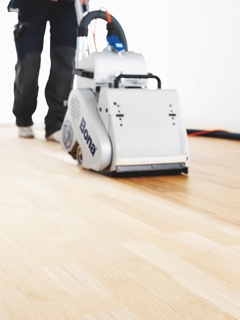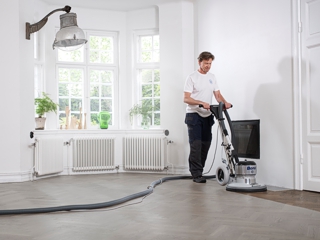In this article, we will talk about the difference between sanding, buffing, and screening, clear some misunderstandings concerning those tasks and advise you when to consider each of them.
What Is Floor Sanding?
 No matter how well you maintain your floor, at some point, it will become distressed. To deal with that, the floor’s protective coating has to be completely removed by stripping it with a specialised equipment and applying a new finish. However, the refinishing won’t be complete if you don’t go all the way and level the floor, remove the warped or damaged floorboards, fill any gaps appearing between them and possibly staining before applying the finish. The typical procedure includes three machines – a belt sander for the majority of the work, edge-sander for those hard to reach places and polishing (buffing) equipment for the final touch.
No matter how well you maintain your floor, at some point, it will become distressed. To deal with that, the floor’s protective coating has to be completely removed by stripping it with a specialised equipment and applying a new finish. However, the refinishing won’t be complete if you don’t go all the way and level the floor, remove the warped or damaged floorboards, fill any gaps appearing between them and possibly staining before applying the finish. The typical procedure includes three machines – a belt sander for the majority of the work, edge-sander for those hard to reach places and polishing (buffing) equipment for the final touch.
Sanding is a complete and thorough removal of previously existing finish required for very distressed hardwood surfaces. It is a regular procedure which should be performed every few years.
What Is Screening?
Screening and buffing and pretty much synonymous. It is a way of renewing your wooden floor by abrading slightly worn finish and re-applying additional coating on top. You may also hear those terms being referred to as 'screen and re-coat' or 'buff and coat'. Some also call this 'light sanding' but it is not entirely correct. You see when screening, you usually only use a buffing machine (rotary sander). It strips some the finish without removing it entirely and can help remove small imperfections. If you, however, have deep scratches or serious stains, the machine won’t be able to deal with that. It is also much easier, cheaper and a lot less time consuming than floor sanding. Keep in mind that it is not enough to just buff more distressed areas or you risk disparity between buffed and untouched places. Every part of your floor will need a treatment - all or nothing!
Screening is performed when the floor is in need of a slight refreshing but is still in decent shape. It is an excellent way to prolong the periods between each sanding.
When Not to Screen?
• If your floor has been waxed you won’t be able to buff it. You’ll need to sand instead because the polisher is simply too weak to abrade the wax.
• If parts of your floor have turned grey a simple screening won’t be enough to get rid of them. You might have to resolve to sanding again.
• If you want to change your floor’s colour you have to stain it as buffing is insufficient for the task.
• If your floorboards are not cupped or warped and don’t have deep scratches or stains.
How Long Does It Take to Buff a Floor?
 During the buffing process is advisable to avoid working only on a single damaged area and leave the rest of the room alone since the difference will be clearly visible. This means that depend on the size of the room and the type of finish used after the procedure. Buffing alone shouldn’t take more than a day. The different types of floor finishes need a different amount of time to dry up. Oil-based polyurethane lacquer will need significantly more time than a water based product. Also, keep in mind that since the whole room has to be buffed, the furniture has to be moved as well. Depending on the type of finish used it’s better to wait two to four days before bringing the furniture back.
During the buffing process is advisable to avoid working only on a single damaged area and leave the rest of the room alone since the difference will be clearly visible. This means that depend on the size of the room and the type of finish used after the procedure. Buffing alone shouldn’t take more than a day. The different types of floor finishes need a different amount of time to dry up. Oil-based polyurethane lacquer will need significantly more time than a water based product. Also, keep in mind that since the whole room has to be buffed, the furniture has to be moved as well. Depending on the type of finish used it’s better to wait two to four days before bringing the furniture back.
